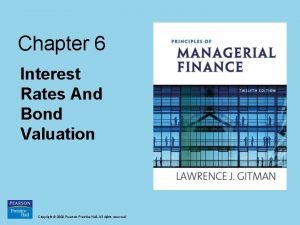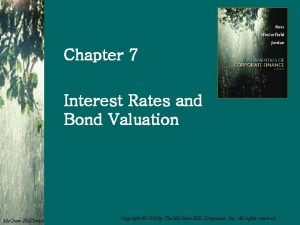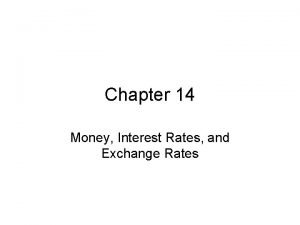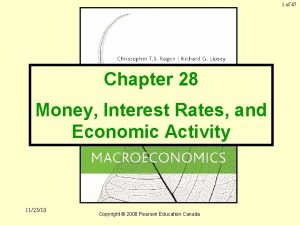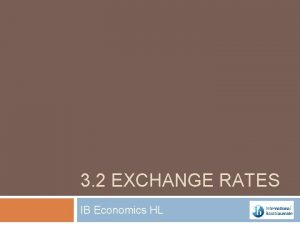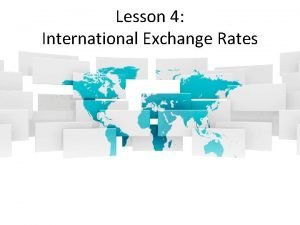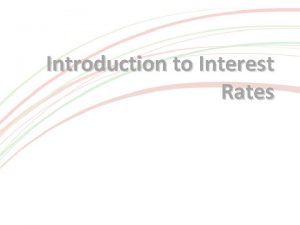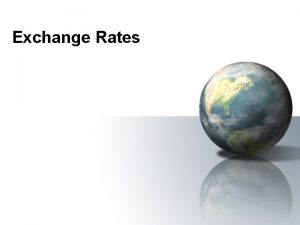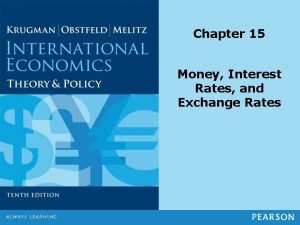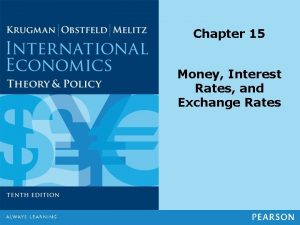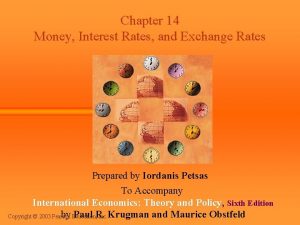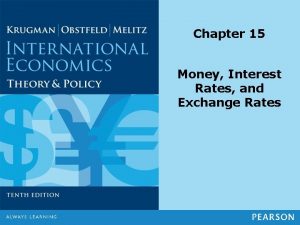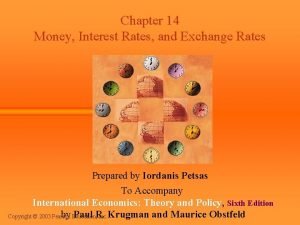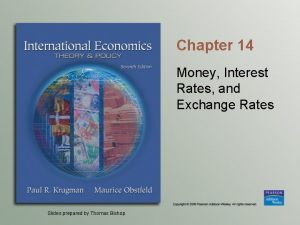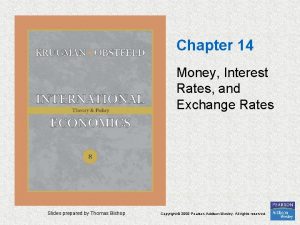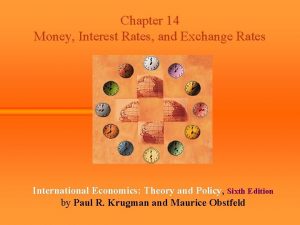Chapter 15 Exchange Rates Interest Rates and Interest















- Slides: 15

Chapter 15 Exchange Rates, Interest Rates, and Interest Parity

Topics to be Covered • Interest Rate Parity • Nominal Interest Rate • Real Interest Rate • Fisher Equation • Exchange Rates, Interest Rates, and Inflation • Expected Exchange Rates and the Term Structure of Interest Rates Copyright © 2007 Pearson Addison-Wesley. All rights reserved. 2

Interest Parity • The interest parity relationship is a result of profit-seeking arbitrage activity called covered interest arbitrage. • A U. S. investor deciding between investing in the U. S. or in the U. K. must consider: The interest rates, i$ and i£ The spot exchange rate, E , (in $/ £) The forward exchange rate, F, (in $/ £) Copyright © 2007 Pearson Addison-Wesley. All rights reserved. 3

Interest Parity (cont. ) • By investing $1 at home, the U. S. investor can earn 1 + i$ for one period. • Or, since $1 = 1/E pounds, the U. S. investor can invest in the U. K. and earn (1 + i£)/E. • Since future spot rates are unknown, the investor can eliminate the uncertainty over the future dollar value of the investment with a forward exchange contract. Copyright © 2007 Pearson Addison-Wesley. All rights reserved. 4

Covered Return • Covered return is the domestic currency value of a foreign investment when the foreign currency proceeds are sold in the forward market. • In our example, the covered return is equal to (1 + i£)F/E dollars. Arbitrage between the two investment opportunities results in: Copyright © 2007 Pearson Addison-Wesley. All rights reserved. 5

Interest Rate Parity • Interest rate parity states that the forward premium (or discount) is equal to the interest differential. This parity is approximated by the equation: Copyright © 2007 Pearson Addison-Wesley. All rights reserved. 6

Effective Return • The effective return on a foreign investment is given by the interest rate plus the expected change in the exchange rate. • Using our example, the effective return is: Copyright © 2007 Pearson Addison-Wesley. All rights reserved. 7

Reasons Why Interest Rate Parity May Not Hold • Buying and selling foreign exchange and international securities involve transaction costs. • Taxes may differ according to an investor’s residence. • Government controls on financial capital flows may exist. • There may be political risks. • There are time lags between observing the profit opportunity and actually trading to realize the profit. Copyright © 2007 Pearson Addison-Wesley. All rights reserved. 8

Interest Rates and Inflation • Nominal Interest Rate—the interest rate actually observed in the market. • Real Interest Rate—the nominal interest rate minus or adjusted for inflation. Copyright © 2007 Pearson Addison-Wesley. All rights reserved. 9

Fisher Equation • The relationship between interest rates and inflation is given by the Fisher equation: where i is the nominal interest rate, r is the real interest rate, and π is the expected rate of inflation. • Refer to Table 15. 1 Copyright © 2007 Pearson Addison-Wesley. All rights reserved. 10

Copyright © 2007 Pearson Addison-Wesley. All rights reserved. 11

Exchange Rates, Interest Rates, and Inflation • Real interest rates are equalized across countries when the Fisher equation, interest rate parity, and relative purchasing power parity all hold. • Given our U. S. and U. K. investment example: • Interest rates, inflationary expectations, and exchange rates are all jointly determined and affected by government policy changes and other news. Copyright © 2007 Pearson Addison-Wesley. All rights reserved. 12

Term Structure of Interest Rates • There is no such thing as the interest rate for a country. • Term structure of interest rates—the pattern of interest rates over different terms of maturity. Copyright © 2007 Pearson Addison-Wesley. All rights reserved. 13

Expected Exchange Rates and Term Structure of Interest Rates • Refer to Figure 15. 1 Eurocurrency Interest Rates • If the term structure lines for two countries are: Parallel, then exchange rate changes are expected to be constant Diverging, then the high-interest-rate currency is expected to depreciate at an increasing rate over time Converging, then the high-interest-rate currency is expected to depreciate at a declining rate relative to the low-interest-rate currency Copyright © 2007 Pearson Addison-Wesley. All rights reserved. 14

Copyright © 2007 Pearson Addison-Wesley. All rights reserved. 15
 Chapter 7 interest rates and bond valuation
Chapter 7 interest rates and bond valuation Chapter 5 bonds bond valuation and interest rates solutions
Chapter 5 bonds bond valuation and interest rates solutions Chapter 6 interest rates and bond valuation
Chapter 6 interest rates and bond valuation Chapter 7 interest rates and bond valuation
Chapter 7 interest rates and bond valuation Chapter 6 interest rates and bond valuation
Chapter 6 interest rates and bond valuation Unit ratio
Unit ratio Ratios guided notes
Ratios guided notes Ratios rates and unit rates
Ratios rates and unit rates Ratios rates and unit rates
Ratios rates and unit rates Ssema
Ssema Interest rates and price level
Interest rates and price level Interest rates and price level
Interest rates and price level Foreign exchange tourism grade 11
Foreign exchange tourism grade 11 Heathrow exchange rates
Heathrow exchange rates Ib economics exchange rates
Ib economics exchange rates Exchange rates lesson
Exchange rates lesson


